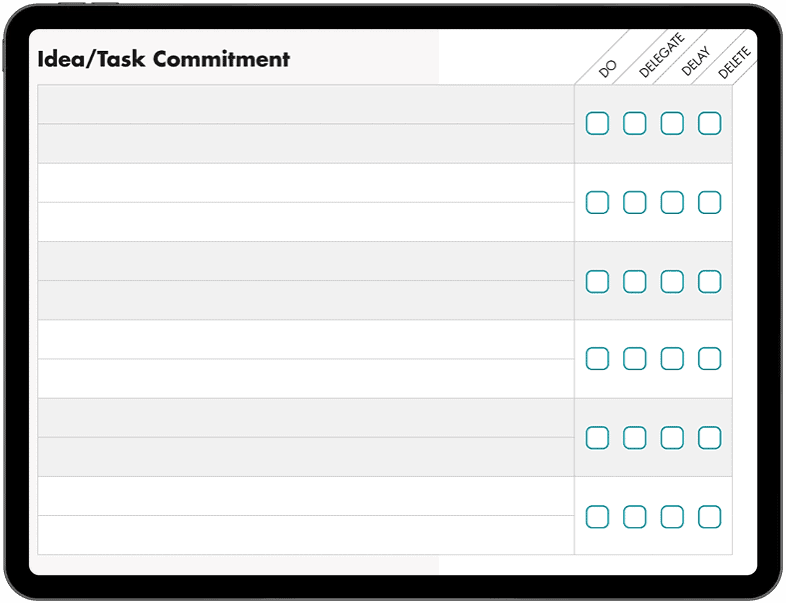If you’re here, you probably have a lot of brilliant and creative ideas for your business. But, you’re just not sure which one to pursue or where to start…
I’m going to walk you through my step-by-step plan for lasering in on your minimum viable product and guide you through taking that product from start to finish so you can finally launch it out into the world.
#1. Brain Dump All Of Your Ideas
The first step in successfully bringing an idea out into the world is identifying which one, of the many you have, to pursue.
But before we can do that, we need to know what ideas are currently occupying space in your mind.
Right now take 5-10 minutes to write down every idea, project, to-do item, or worry that’s on your mind. Think of yourself as an observer of your thoughts, walking through a wild forest that hasn’t had a visitor in awhile…
You might notice things that have been there for awhile, like an old tree that’s been a steady presence and would like to be acknowledged. And you might also see new little idea sprouts, that hold a lot of potential if you can nurture them properly.
Once you’ve written down all of the ideas for your online courses, your book, your website… how you need to clear out the closet, pick up some floss, and call your aunt Sally… It’s time to sort through and process these ideas, thoughts, and tasks.
Beside each item, write down whether the task is a something you should: Do, Delegate, Delay, or Delete.
There might be some things that aren’t pressing, so you can delay them to give your mind some breathing space.
Other things might have outlived their usefulness and be deleted entirely.
In order to make space and time to work on your best ideas, it helps to delegate – whether that means asking your kids to help with a chore, hiring someone for a one-time project, or passing something on to a team member or contractor who can do the task just as well, if not better than you can.
#2. Identify The Idea You’re Going To Pursue


Ideas are nothing without execution and implementation.
Keep in mind that it can be difficult to work on more than one idea at a time and it’s easier to become known for one thing, so you can build on and expand from there.
Let’s identify which idea (singular!) that you’re going to pursue and nurture. And remember, we’re not talking about marrying yourself to an idea, you’ll want to be able to adapt if it doesn’t work out as you’re working on it more over time.
Take out your notes from the previous step, where you wrote down all of the thoughts you had as an observer.
Beside each of the “Do” items, write down a priority number… with number one being the idea that sparks the most excitement for you. You’ll also want to factor in the potential return on investment for this idea. For example, if you’re looking to create an online course but you have two different topics you could teach… go with the one that has more potential customers based on feedback you’ve received from your community or noted within communities you are part of, or that might be faster and easier for you to create.
Take a few minutes to evaluate your ideas (and if new ones pop up, add them to your idea list!).
After prioritizing them, pick the idea you’re going to nurture and grow into a successful venture.
#3. Research The Industry
To make sure your idea will “make it”, it helps to explore your industry, the marketplace at large, and to understand the people who might buy into your idea… and help you spread the word about it.
You need to observe the conditions in the marketplace to know if your idea will thrive… or if it will be choked out by competing ideas that are already established.
In my opinion, there’s always room for another teacher, course, or book in any industry… If you position yourself and your idea strategically, and focus on solving the problems of your customers.
The first step in exploring the marketplace you’re about to enter is to make a list. In the case of an online course or membership site, that means knowing what other courses exist on your topic, who are the other thought leaders in this space, and what customers are looking for.
Spend some time researching and making a list of your idea’s possible competition, cooperation, and customers.
For potential competitors, write down pertinent information like: pricing, scope of the course, strengths and weaknesses.
On the flip side, look at possible allies and partners that could help you spread the word about your idea, course, or product: people you already know, leaders in the field you might want to befriend, and existing customers and fans.
Your idea needs to benefit your potential clients, readers, or participants. But you’re not a mind reader, so the best way to make sure your idea meets their needs is to ask. Meet with at least 3 past or potential customers of your new idea and start asking them questions. Here are 3 prompts to help guide these discussions. Note you’ll want to make them more specific to your industry:
- What keeps you up at night?
- What have you tried that hasn’t worked, and why?
- If we were talking 3 years from now and looking back, what would have had to happen for you to be happy with your progress?
Make extensive notes, and keep track of the exact words and sentence fragments that you hear. That’s why I recommend doing this over the phone or in person… although written works, too.
Take the time you need to map the existing ecosystem so you’re not headed in the wrong direction with your idea.
#4. Make Your Product Uniquely Yours
First, I have to tell you straight up: your idea is unique. By virtue of the fact that your idea came to you, and that you have a unique story, life experience, and background that no one else has. No one can copy your life, your personality, or your beliefs. Those are yours.
In the previous step you might have seen something out there that’s eerily similar to your idea… but here’s why that’s a good thing.
If you see something similar to your idea in the marketplace already, and it’s succeeding… then it means that there’s a viable business case for it.
What will help your idea succeed in a possibly crowded space, is to give it a head start by making it strategically unique.
Not sure what that looks like yet? Look at the data you gathered about the existing marketplace, and see where the patterns are.
Is there anywhere you could zig where your competition zags? Are there any weaknesses your competitors exhibit that you could shore up with your idea or product? Is there anything that your potential customers repeated a lot, or that’s an unaddressed problem in the existing marketplace?
For example, if you’re creating an online course and all of your competitors offer an 8 week video course… could you make yours an 8 day video course for people who are really busy and want results fast?
Could you do the work for your customers through a service, instead of giving them a how-to ebook? Could you help people who are brand new get started, or offer something that no one else has thought of yet?
Write down some of your ideas for strategically differentiating your product or course.
Here’s a formula for describing it: My idea helps [who], do [what], unlike [competitors].
For example: My online course helps women with cravings stop binging on junk food while feeling satiated, unlike most diets that focus on calorie counting.
You might need to play with the wording here, and ask for feedback to see if your statement is communicating your idea’s power.
#5. Leave Perfectionism At The Door
The biggest threat to your minimum viable product launch is your resistance to doing the work, your perfectionism, and your self-doubt.
Let’s talk about procrastination and perfectionism, and how it leads to half-baked products that rot on the vine… when they started out with so much potential.
In our experience, gaining momentum with an idea or new product helps you see it through to completion. We recommend doing something to move your development forward every day.
Here’s where it’s important to distinguish between taking small steps, and procrastinating. Procrastination stems from perfectionism, plain and simple. We all want to do our best work, and unless there’s an external deadline we’re likely to put off working on our ideas because we see what they could be… and we’re afraid that we won’t be able to fulfill on our vision with our current skill set or resources.
If you don’t start, and keep working to create your minimum viable product, then you’re guaranteed not to fulfill your vision. At all.
We see this a lot with online course creators. They want to do it all in the first iteration and end up not following through. If you get to the 80% finish line. Or, put another way… write a shitty first draft. The way to push perfectionism out for good is to make a deal with yourself that you’re not going to do perfect work… it’ll only ever be 80% of what you’re capable of. But this is good enough… to feel like 100% from someone else’s perspective.
Your work is still going to change lives, even if there was one more thing you could have done to make it better. So if you’ve been procrastinating, or telling yourself that your idea and the work you’ve been doing on it isn’t good enough… stop that! Your only focus here is to do an “above average” job with your first draft for your course and let the refinement happen over time.
#6. Validate Your Offering
It can be disheartening to launch a course, business, or project into the world and not get the financial results we were hoping for.
To sidestep this pitfall, and get your idea to succeed you need validation.
No one wants to spend a ton of time and money working on something that won’t take off. But asking your friends or family members if they like your idea isn’t a wise choice… because they’re not your ideal customers, and they’ll either be politely supportive or overly critical. Neither of which is helpful feedback to improve your idea, and make it viable and profitable.
That’s where testing with micro-commitments comes in. How do you do that? You can start with a simple blog post, a social media post, or even running an ad. If you start getting some traction on the concepts and idea that you’re sharing, you’ll know you’re on the right track.
So continuing with our example of an online course, you might post something like: “If I were to start teaching women with cravings how to stop binging on junk food while feeling satiated, instead of dieting and calorie counting… would you be interested?”
If you get some positive responses, then you’ll know to keep going and you can even build an interest list of potential customers this way.
Or, you might post two different potential titles for your course and see what feedback you get.
#7. Create Your Marketing Campaign
This is usually called launching a course or product, and there are as many different strategies for doing it as there are unique ideas.
But the basic premise of introducing your minimum viable product, aka your MVP, to the world is this:
- Find your ideal audience: this is usually done by building an email list, or a community on social media. Basically a way to get in touch with the right people, at the right time.
- Give them a taste of your product: through free content that offers solutions and results before you ever ask for an investment in your paid course or product.
- Give them a chance to jump on board with your idea: by giving them all the information they need to decide if it’s right for them. This is where the sale takes place for a paid course or product.
- Deliver on your idea: with your membership site or online course, in whatever format you chose.
- Ask them to spread the word about the idea: because they likely know many other people just like them.
Each of these steps could be an entire course that we could teach on its own, but the biggest thing to remember when you’re introducing your product to the world is that…
How you describe your idea, and what it can do for people, is just as important as the idea itself.
Use the statement we crafted above and focus on the benefits to your customers.
#8. Build Your Course On A Solid Foundation
Once you’ve validated your idea, and know that you have a winning offer, it’s time to deliver it.


Your tech stack is just as important as the product itself. And, after the work you’ve put into carefully curating this offer, you’ll want to have a tech foundation that’s built to scale as your business grows over time.
Give your product the opportunity to reach its full potential when you power it with AccessAlly, the learning management system of choice for industry leaders.
This powerful LMS and membership management plugin makes it possible to set up your mimimum viable product so you can continue to add-on and refine it over time without having to migrate from one membership or LMS plugin to the next, with each iteration as you evolve and scale.
#9. Rinse And Repeat
When you trust the process that you’ve been following here and give the world a chance to respond to your product… you’ll get the best results.
Just like you wouldn’t dig up a seed that you planted just to check and see if it started sprouting, because that would undo the work and could even kill the plant… You wouldn’t launch a course or idea into the world, and then remove the sales page or stop sending marketing messages about it abruptly.
When you commit to launching a new product, see it through. If only so that you can go all the way through producing an idea and seeing how the market responds… you can use this feedback to improve your product and re-launch it better and stronger.
A Story From Our CEO
My very first online course attempt was a total flop. I didn’t know what I was doing but I figured I could follow the steps I saw other businesses take: I put together a free call, wrote up a sales page and opened registration to my first online course… to the sound of crickets. Nobody bought what I was selling and I was mortified!
What would people think if they knew I didn’t sell a single spot? But I went back to the drawing board, worked with a seasoned coach, and most importantly spoke to my ideal customers… and just a few months later, my course release had a very different story.
During this launch, my email list grew from a handful of subscribers to over 500 people, and I made my first $3000 in just a few weeks!
From there I was able to build on and re-launch the same program, turning it into a viable business.
But none of this would have been possible if I hadn’t released my minimum viable product and gotten real world feedback to help me improve my course and marketing.
In my case the feedback was clear: I wasn’t speaking to people’s desires and needs. When I repositioned my idea, and followed the steps I walked you through here… I had a winning product.
So trust that your idea will find its roots, and grow along with you as a business owner and creative. You’ve come a long way, don’t hold back your brilliant ideas from the world any longer. The process for getting your ideas out to market successfully is never done. I’m constantly revisiting these steps in my own ideation process.
So the next time you find yourself creatively blocked, or ready to work on a new product or course… come back and work through the exercises again.




